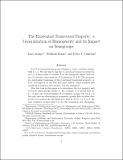Files in this item
The existential transversal property : a generalization of homogeneity and its impact on semigroups
Item metadata
| dc.contributor.author | Araújo, João | |
| dc.contributor.author | Bentz, Wolfram | |
| dc.contributor.author | Cameron, Peter J. | |
| dc.date.accessioned | 2020-09-14T15:30:04Z | |
| dc.date.available | 2020-09-14T15:30:04Z | |
| dc.date.issued | 2021-02 | |
| dc.identifier | 269765678 | |
| dc.identifier | 2cf341e2-5351-44ef-8e5a-041f97b01315 | |
| dc.identifier | 85099364874 | |
| dc.identifier | 000607645000015 | |
| dc.identifier.citation | Araújo , J , Bentz , W & Cameron , P J 2021 , ' The existential transversal property : a generalization of homogeneity and its impact on semigroups ' , Transactions of the American Mathematical Society , vol. 374 , no. 2 , pp. 1155–1195 . https://doi.org/10.1090/tran/8285 | en |
| dc.identifier.issn | 0002-9947 | |
| dc.identifier.other | ORCID: /0000-0003-3130-9505/work/80257837 | |
| dc.identifier.uri | https://hdl.handle.net/10023/20622 | |
| dc.description | Funding: The first author was partially supported by the Fundação para a Ciênciae a Tecnologia (Portuguese Foundation for Science and Technology) through the projects UIDB/00297/2020 (Centro de Matemtica e Aplicaes), PTDC/MAT-PUR/31174/2017, CEMAT-CIÊNCIAS UID/Multi/04621/2013, and through the project “Hilbert’s 24th problem” (PTDC/MHC-FIL/2583/2014). The second author was supported by travel grants from the University of Hull’s Faculty of Science and Engineering and the Center for Computational and Stochastic Mathematics. | en |
| dc.description.abstract | Let G be a permutation group of degree n, and k a positive integer with k ≤ n. We say that G has the k-existential property, or k-et, if there exists a k-subset A (of the domain Ω) whose orbit under G contains transversals for all k-partitions P of Ω. This property is a substantial weakening of the k-universal transversal property, or k-ut, investigated by the first and third author, which required this condition to hold for all k-subsets A of the domain Ω. Our first task in this paper is to investigate the k-et property a≤nd to decide which groups satisfy it. For example, it is known that for k< 6 there are several families of k-transitive groups, but for k ≥ 6 the only ones are alternating or symmetric groups; here we show that in the k-et context the threshold is 8, that is, for 8 ≤ k ≤ n/2, the only transitive groups with k-et are the symmetric and alternating groups; this is best possible since the Mathieu group M24 (degree 24) has 7-et. We determine all groups with k-et for 4 ≤ k ≤ n/2, up to some unresolved cases for k=4,5, and describe the property for k=2,3 in permutation group language. These considerations essentially answer Problem 5 proposed in the paper on k-ut referred to above; we also slightly improve the classification of groups possessing the k-ut property. In that earlier paper, the results were applied to semigroups, in particular, to the question of when the semigroup <G,t> is regular, where t is a map of rank k (with k < n/2); this turned out to be equivalent to the k-ut property. The question investigated here is when there is a k-subset A of the domain such that <G,t> is regular for all maps t with image A. This turns out to be much more delicate; the k-et property (with A as witnessing set) is a necessary condition, and the combination of k-et and (k-1)-ut is sufficient, but the truth lies somewhere between. Given the knowledge that a group under consideration has the necessary condition of k-et, the regularity question for k ≤ n/2 is solved except for one sporadic group. The paper ends with a number of problems on combinatorics, permutation groups and transformation semigroups, and their linear analogues. | |
| dc.format.extent | 699774 | |
| dc.language.iso | eng | |
| dc.relation.ispartof | Transactions of the American Mathematical Society | en |
| dc.subject | Transformation semigroups | en |
| dc.subject | Regular semigroups | en |
| dc.subject | Permutation groups | en |
| dc.subject | Primitive groups | en |
| dc.subject | Homeogenous groups | en |
| dc.subject | QA Mathematics | en |
| dc.subject | Mathematics(all) | en |
| dc.subject | T-NDAS | en |
| dc.subject | BDC | en |
| dc.subject | R2C | en |
| dc.subject.lcc | QA | en |
| dc.title | The existential transversal property : a generalization of homogeneity and its impact on semigroups | en |
| dc.type | Journal article | en |
| dc.contributor.institution | University of St Andrews. Pure Mathematics | en |
| dc.contributor.institution | University of St Andrews. Centre for Interdisciplinary Research in Computational Algebra | en |
| dc.identifier.doi | https://doi.org/10.1090/tran/8285 | |
| dc.description.status | Peer reviewed | en |
This item appears in the following Collection(s)
Items in the St Andrews Research Repository are protected by copyright, with all rights reserved, unless otherwise indicated.

